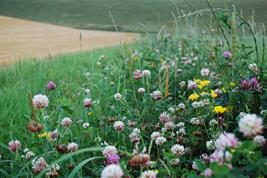15.02.2024

In a recently published study, a large international consortium of biodiversity scientists utilized synthesis data to show the synchronized response of communities to land-use.
The study provides evidence, that higher agricultural land-use has direct and indirect effects on the community leading to faster growth and nutrient cycling in most guilds. This has consequences for functional biodiversity as well as for ecosystem functions like nutrient fluxes, carbon sequestration and productivity.
They analyzed traits and occurrence data of more than 2800 protozoa, fungi, plants and animal species from grassland plots in three long-term study areas in Germany, the DFG-funded Biodiversity Exploratories. The working group “Sustainable grassland systems” from Leibniz Centre for Agricultural Landscape Research (ZALF) contributed data and plant root trait expertise for this endeavor.
The study „A slow-fast trait continuum at the whole community level in relation to land-use intensification” has been published on 10 February 2024 in the journal Nature Communications.
Further Information:
